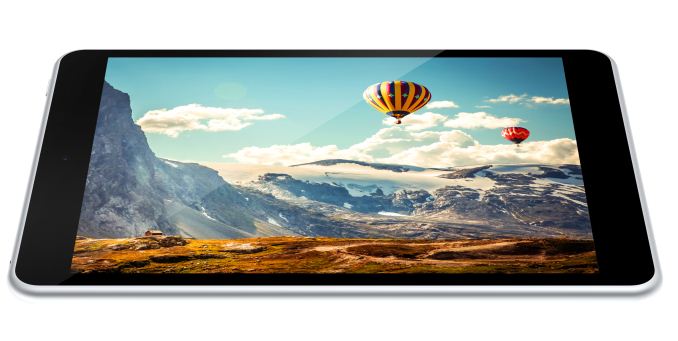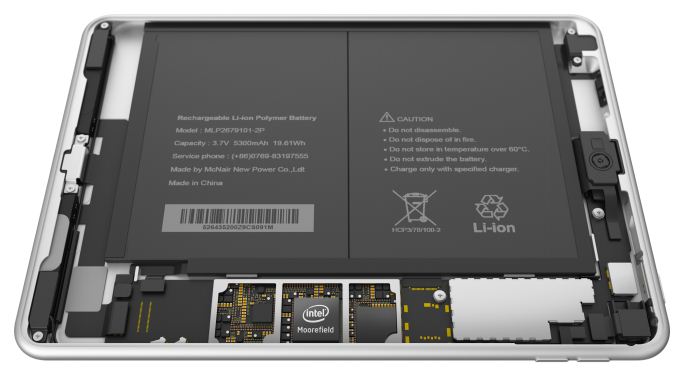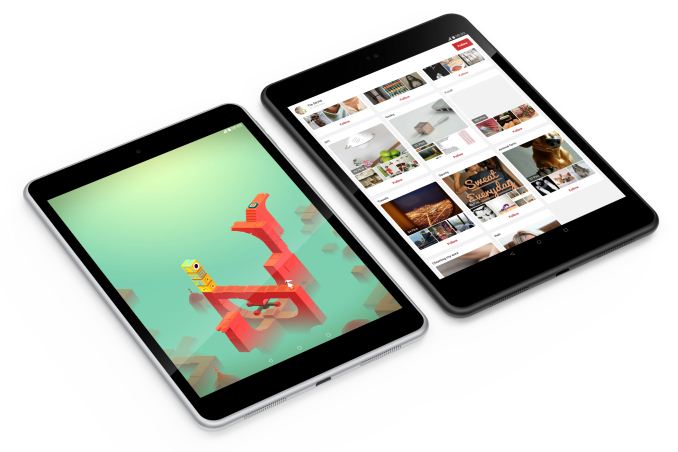Nokia Announces N1 Tablet: 7.9” & Powered By Android
by Ryan Smith on November 18, 2014 7:30 AM EST
Since selling their mobile device division to Microsoft, much contemplation has been had over the future of Nokia. As it slowly turns out, their future is not all that different from the past. Except perhaps that there’s a lot more Android in Nokia’s future.
As part of the Slush 2014 conference, Nokia has announced their next consumer gadget, a new tablet going by the name Nokia N1. Measuring at 7.9” diagonal, powered by an Intel CPU, and running Android Lollipop, the N1 is Nokia’s first tablet since selling their mobile device division.
From a design perspective I’m not sure there’s anything to call the N1 other than an unabashed duplicate of the iPad Mini. Built out of a single piece of aluminum, the N1 incorporates the iPad’s 7.9” diagonal size and many of its stylings, including curves, button placements, and even the location of the headphone jack. Short of the iPad’s home button, at first glance you would be hard pressed to tell the N1 and iPad Mini apart.
In any case, while in many ways Nokia is looking to learn from the masters here, the N1’s design does have some elements that set it apart (and ahead) of the iPad Mini and similar tablets. Nokia has been able to drive the tablet to just 6.9mm thick and 318g heavy – thinner and lighter than any iPad Mini. Meanwhile the display has been fully laminated, with Nokia eliminating any kind of air gap between the display panel and the cover glass.
In terms of technical specifications Nokia is tapping Intel’s Atom Z3580 to power the device. Z3580 includes a quad-core Silvermont processor running at 2.3Ghz, along with an Imagination PowerVR G6430 running at 533MHz. Paired with the processor is 2GB of LPDDR3-1600, Bluetooth 4.0, and 802.11ac WiFi. Meanwhile the 7.9” 4:3 IPS display is 2048x1536 pixels, once again identical to the retina iPad Mini. Powering the device will be an 18.5Whr battery.
| Tablet Specificaiton Comparison | |||
| Nokia N1 | iPad Mini 3 | NVIDIA SHIELD Tablet | |
| SoC | Intel Atom Z3580 | Apple A7 | Tegra K1 |
| CPU | 4x Silvermont @ 2.3Ghz | 2x Cyclone @ 1.3GHz | 4x Cortex A15r3 @ 2.2GHz |
| GPU | PowerVR G6430 @ 533MHz | PowerVR G6430 | Kepler (1 SMX) |
| RAM | 2GB LPDDR3-1600 | 1GB LPDDR3 | 2GB DDR3L-1866 |
| NAND | 32GB NAND (eMMC 5.0) | 16GB/64GB/128GB NAND | 16GB/32GB NAND + microSD |
| Display | 7.9" 2048 x 1536 IPS LCD | 7.9" 2048 x 1536 IPS LCD | 8” 1920 x 1200 IPS LCD |
| Dimensions | 200.7 x 138.6 x 6.9mm, 318 grams | 200 x 134.7 x 7.5mm, 331 grams | 221 x 126 x 9.2mm, 390 grams |
| Camera | 8MP Rear Camera 5MP FFC |
5MP Rear Camera 1.2MP FFC |
5MP Rear Camera 5MP FFC |
| Battery | 5300 mAh, 3.7V chemistry (19.61 Whr) | 23.8Whr | 5197 mAh, 3.8V chemistry (19.75 Whr) |
| OS | Android 5.0 + Nokia Z Launcher |
iOS 8 | Android 4.4.2 |
| Connectivity | 802.11a/b/g/n/ac + BT 4.0, USB Type-C (USB 2.0) | 802.11a/b/g/n + BT 4.0, Lightning (USB 2.0) | 2x2 802.11a/b/g/n + BT 4.0, USB2.0, mini HDMI 1.4a |
| Price | $249 (32GB) | $399 (16GB) $499 (64GB) |
$299 (16GB/WiFi) $399 (32GB/LTE) |
One notable first here, Nokia is utilizing the new USB Type-C connector for the tablet, and not entirely in the way we’d expect. With the Type-C connector serving as Nokia’s analogue to Apple’s Lightning, Nokia is using what they call a “Micro-USB 2.0 with a Type-C reversible connector” setup, which means that while this is a Type-C connector it is only wired up for USB 2.0 and not USB 3.0. Given the design goals of the Type-C connector, we expect this will be the first of many such mobile devices to make use of it in the coming months.
Vision for the N1 will be provided by a pair of cameras on the front and back. The rear camera is an 8MP camera with autofocus and is capable of recording video at 1080p. Meanwhile the smaller front camera is 5MP and utilizes fixed focus. Finally, the tablet comes in a single storage configuration of 32GB, with Nokia’s NAND driven through eMMC 5.0.
On the software side of matters, the N1 will run a semi-customized version of Android Loliipop. In this case Nokia has made only a handful of changes, primarily replacing the standard Android launcher with their newly released Z Launcher.
Finally, while the N1 is a Nokia branded product, Nokia is calling special attention to their manufacturing arrangement with tablet partner Foxconn. As part of Nokia’s development strategy, the industrial design, IP, and Z Launcher software are being licensed to Foxconn for the production of the tablet. Foxconn in turn basically assumes all further responsibilities for the product, including business execution, engineering, and support, in many ways making this a Foxconn tablet with Nokia software and branding.
No doubt due in part to this reason, the N1 will be launching first in China before coming to other regions. Nokia’s official announcement states that it will be launching in China in Q1’15 for the equivalent of $249 USD (before taxes) with no further markets announced at this time. Meanwhile BGR is reporting that it is expected to launch in China after Chinese New Year, with further releases in Russia and parts of Europe in the following months. To that end there are no currently announced plans to bring the N1 to North America, though at this stage by no means does it mean that the N1 won’t come at a later date.
Source: Nokia




















54 Comments
View All Comments
SirPerro - Tuesday, November 18, 2014 - link
Hopefully this will come with Google Play services. Happy to see Nokia alive (And a little bit dissapointed that their first new product is a blatant rip-off of the iPad mini)Flunk - Tuesday, November 18, 2014 - link
I think you might be missing the big picture. Nokia sold their entire devices devision to Microsoft, all they kept was HERE and licensing. This is a Foxconn product (even that custom launcher was likely outsourced) and they're just paying Nokia for the brand. Nokia is as alive as Frankenstein's monster or Atari.metro-sf - Tuesday, November 18, 2014 - link
>> even that custom launcher was likely outsourcedIt is developed by Nokia in Silicon Valley (at Nokia North American headquarters in Sunnyvale).
Penti - Tuesday, November 18, 2014 - link
They kept some people doing general R&D around 500 or so. That was the former Nokia Research Center. They also has all the network business intact. So while they lost almost 60 000 people on the device business which is no more since Elop came into the picture (25 500 ended up transfered to Nokia when the deal went through, other left were Indian factory workers that is now booted) and some in NSN. They are still some 60 000 strong. The cutbacks in the network sector is done and they have even began to hire more staff again. But this isn't their core business and every facility Devices and Services had is closed or in Microsoft's hand. They have no competence building consumer devices left. Though they have plenty of competence in it's mapping business that's invested into delivering mapping data and navigation apps for a whole range of systems including consumer stuff like Android phones.Don't see this as much different to when they sold Nokia branded netbooks. They are also not allowed to sell phones until after 2016 if they want to.
TheLogicBringer - Tuesday, November 18, 2014 - link
Nokia is not, nor has ever been 60 000 strong. They lost 25 000 employees to Microsoft and another 12 000 employees they are employing on behalf of Microsoft because acquiring them was too difficult with the countries they were in. they had 53 000 employees, and lost 37 000, they now have 16 000 employees and likely have cut many of them already anyways. Since nokia was not exclusively a hardware company those remaining staff are largely to do with there networking and software/map endeavours. The nokia branded net books sucked, so I agree that there likely will not be much difference.Nokia as we knew it is in the hands of Microsoft now.
kpkp - Wednesday, November 19, 2014 - link
You mean, Nokia as we knew it was ruined by Microsoft (or it's people).Valantar - Wednesday, November 19, 2014 - link
Oh, how I love reverse fanboyism. So Nokia was all fine and dandy after sticking to the outdated (and truly awful UX-wise) Symbian platform for years after the advent of iOS and Android? With the staggering success of such ground breaking consumer favourites as the 5800 Xpressmusic? I think not. When Elop arrived, they had been making conservative, piss-poor business decisions for years. Yep, Stephen Elop and his bet on WinPho wasn't a resounding success story, but all that happened was the continuation of a downward trend which had been going since the iPhone, if not earlier. As of now, it actually has been looking better for their smartphone market share for a few quarters, at least in Europe. However, they've been held back by bad hardware design (weight and thickness issues, mainly) just as much as software for the last couple of years. As well as the crushing dominance of the iOS and Android ecosystems, of course.Tl;dr: Nokia was 'ruined' long before Elop got there.
craighamilton - Saturday, December 6, 2014 - link
Not my first choice as there are lot of better and high rated tablets in the market (see http://www.topreport.org/tablets/ for example...)Penti - Wednesday, November 19, 2014 - link
Nokia Devices & Services division including Nokia Research Center but not Corporate Common was employing 58 642 in 2010 on average, the whole company just under 130 000. Under several points during 2010 did Nokia Corp employ more than 60 000 people and at the same time more than 60 000 people at NSN or it's network subsidiary. Around 30 000 people was laid off the Devices & Services division before it was sold, about 25 500 went to Microsoft of which half has been laid off after the transfer. The India mobile phone plant has been slowing down and has been given the orders to close removing the remaining Nokia employees and contract workers working on phones. The point was nothing is left. There's nothing to salvage. Not when it comes to consumer devices. All that worked on constructing, testing and developing those types of devices is gone, all that worked on software on them is gone. Nokia still has manufacturing/assembly plants for Networking equipment, but they won't be building tablets in those. Nokia Technologies and Corporate common is at just under 900 people now, but Nokia has 59 000 people including all three divisions/subsidiaries.So I don't know how you come up with any figures here, it's a public company so it's in their reports, and you can't exactly count the contract workers. It's any way about 60 000 strong today. With only a few researches left from what was devices & services.
mmrezaie - Tuesday, November 18, 2014 - link
I played a little with Z launcher. It was nice but still needs work to do since widgets weren't good for simply showing information that I want and I couldn't config them for my liking. Also it is slow right now. But mostly I would like to see how much they will support the core os. Do we get the upgrades or is it just another samsung!